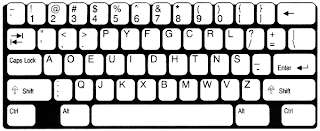Dvorak...
I've recently decided to try a little experiment. On my old PowerBook, I have decided to rearrange the keyboard. It now has the Dvorak Simplified Keyboard layout. I'm still quite slow on it, but I only just changed the keys last night. It does feel like a more natural way of typing the English language.
For those who don't know, here is what the Dvorak keyboard looks like:
The main principle behind its design were to make one's fingers alternate between vowels on the left hand and the heavily used consonants on the right hand. I'm actually typing this entry using this system, and I can already tell the difference. So far I think the hardest change is the 'L' key.
I have had an interest in the Dvorak system ever since I was little. I remember reading an article about it in US News and World report and being mystified by the fact the QWERTY keyboard was designed to slow a typer down. What boggled my mind even more was that people didn't switch to a better keyboard with the creation of the electric typewriter or the personal computer. So I've always had an inclination try it out, and now that I have an abundance of computer gear I figured I'd be able to learn without interfering with others' work.
While seeking the settings for this different setup, I came across this article which had apparently been originally published almost exactly one century after the invention of the first typewriter. It shows some of the research Dr Dvorak of the University of Washington, Seattle did. It is quite a fascinating read. For a little more information, I also read the Dvorak keyboard entry at Wikipedia.
So far, I like the way this works. Besides, what can it hurt? It's not like learning this new system means I'll suddenly forget how to type the other way. With each new musical instrument I get under my fingers, I'm still able to play my saxes with no trouble. I highly recommend this experiment to anyone if they have time enough without anything urgent on their plate.
Ta~


No comments:
Post a Comment